
|
|
Font Size:
|
||||
|
|
|
|
||||
STATISTICAL BRIEF #77:
Antidepressant Use in the U.S. Civilian Noninstitutionalized Population, 2002
Highlights
- In 2002, 8.5 percent of the U.S. civilian noninstitutionalized population used an antidepressant.
- A higher percentage of the elderly used an antidepressant (13.2 percent) than both non-elderly adults (10.3 percent) and children (1.7 percent).
- The percentage of white non-Hispanics using an antidepressant (10.6 percent) was more than double the percentage of black non-Hispanics (4.0 percent) and Hispanics using an antidepressant (3.6 percent).
- The percentage of females using an antidepressant (11.4 percent) was more than twice as large as the percentage of males using an antidepressant (5.4 percent).
- The percentage of persons with only public insurance using an antidepressant (11.0 percent) was higher than those with any private insurance (8.5 percent) or those who were uninsured using an antidepressant (4.7 percent).
- The percentage of persons reported as being in fair or poor mental health using an antidepressant (32.6 percent) was over four times higher than those reported as being in excellent, very good, or good mental health (6.9 percent).
- The percentage of persons who were married at one time but were no longer married who were using an antidepressant (15.3 percent) was higher than those who were currently married (10.6 percent) or single using an antidepressant (6.9 percent).
Introduction
This Statistical Brief examines variations in the percentage of persons in the U.S. civilian noninstitutionalized population who used antidepressants in 2002, by select person characteristics. The person characteristics analyzed in the brief include age, race/ethnicity, sex, insurance status, perceived health status, perceived mental health status, and marital status.
The data used to produce the estimates in this brief are derived from the Household Component of the Medical Expenditure Panel Survey (MEPS-HC) for 2002. Over-the-counter medicines and free samples are not included in these estimates. Results discussed are statistically significant at the 0.05 level.
Findings
In 2002, 8.5 percent of the 288.2 million persons in the U.S. civilian noninstitutionalized population purchased at least one antidepressant prescribed medicine. (figure 1)
In 2002, a higher percentage of the elderly age 65 and older used an antidepressant (13.2 percent) than non-elderly adults age 18 to 64 (10.3 percent). Both elderly and non-elderly adults had a higher percentage of those using an antidepressant in 2002 than children less than 18 years old (1.7 percent). (figure 1)
The percentage of white non-Hispanics using an antidepressant (10.6 percent) was more than double the percentage of black non-Hispanics (4.0 percent) and Hispanics (3.6 percent) using an antidepressant in 2002 and was nearly twice the percentage of other races non-Hispanic using an antidepressant (5.4 percent), as well. Moreover, the percentage of other races non-Hispanic using an antidepressant was higher than the percentage of Hispanics using an antidepressant in 2002 (5.4 percent versus 3.6 percent). (figure 2)
In 2002, the percentage of females using an antidepressant (11.4 percent) was more than double the percentage of males using an antidepressant (5.4 percent). (figure 3)
A higher percentage of those with public insurance only used an antidepressant (11.0 percent) than those with any private insurance (8.5 percent) and the uninsured (4.7 percent) in 2002. Moreover, a higher percentage of persons with any private insurance used an antidepressant than the uninsured in 2002 (8.5 percent versus 4.7 percent). (figure 4)
In 2002, the percentage of those persons reported as being in fair or poor health using an antidepressant (23.9 percent) was more than three and one-half times the percentage for those persons reported as being in excellent, very good, and good health and using an antidepressant (6.6 percent). (figure 5)
Moreover, the percentage of those persons reported as being in fair or poor mental health using an antidepressant (32.6 percent) was more than four times the percentage for those persons reported as being in excellent, very good, and good mental health status and using an antidepressant (6.9 percent) in 2002. (figure 6)
In 2002, for those persons age 16 and older, the percentage of those who at one time were married but were no longer married (widowed, divorced, or separated) and who were using an antidepressant (15.3 percent) was more than double the percentage of those who were single and using an antidepressant (6.9 percent) and was higher than the percentage of those who were married and using an antidepressant (10.6 percent). Moreover, the percentage of those age 16 and older who were married and using an antidepressant (10.6 percent) was higher than the percentage of those who were single using an antidepressant (6.9 percent). (figure 7)
Definitions/Methodology
Use
Use was defined as one or more household reported purchases of an antidepressant prescribed medicine.
Age
Age was usually based on the sample person's age at the end of the year. If the person was not in the survey at the end of the year, then age at the time they were last in the survey was used.
Racial and ethnic classifications
Classification by race and ethnicity was based on information reported for each family member. Respondents were asked if each family member's race was best described as American Indian, Alaska Native, Asian or Pacific Islander, black, white, or other. They also were asked if each family member's main national origin or ancestry was Puerto Rican; Cuban; Mexican, Mexicano, Mexican American, or Chicano; other Latin American; or other Spanish. All persons whose main national origin or ancestry was reported in one of these Hispanic groups, regardless of racial background, were classified as Hispanic. Since the Hispanic grouping can include black Hispanic, white Hispanic, Asian and Pacific Islanders Hispanic, and other Hispanic, the race categories of black, white, Asian and Pacific Islanders, and other do not include Hispanic. Beginning in 2002, MEPS respondents were allowed to report multiple races, and these persons were included in the other non-Hispanic category. As a result, there was a slight increase in the percentage of persons classified in this category in 2002 compared with prior years.
Health insurance status
- Private coverage: Private health insurance coverage was defined as nonpublic insurance that provided coverage for hospital and physician care (including Medigap coverage).
- Public only coverage: People were considered to have public only health insurance coverage if they were not covered by private insurance, and they were covered by Medicare, Medicaid, TRICARE, or other public hospital and physician coverage.
- Uninsured: People who did not have insurance coverage at any time during the survey year were classified as uninsured. People who were covered only by noncomprehensive State-specific programs (e.g., Maryland Kidney Disease Program) or private single service plans (e.g., coverage for dental or vision care only, coverage for accidents or specific diseases) were considered to be uninsured.
In every round, the respondent was asked to rate the health of every member of the family. The exact wording of the question was: "In general, compared to other people of (PERSON)'s age, would you say that (PERSON)'s health is excellent, very good, good, fair, or poor?" For this report, the response categories "excellent," "very good," and "good" were collapsed into one category, as were the response categories "fair" and "poor."
Perceived mental health status
In every round, the respondent was asked to rate the mental health of every member of the family. The exact wording of the question was: "In general, would you say that (PERSON)'s mental health is excellent, very good, good, fair, or poor?" For this report, the response categories "excellent," "very good," and "good" were collapsed into one category, as were the response categories "fair" and "poor."
Marital status
Current marital status was collected and/or updated during every round of the MEPS interview. If marital status of a specified round differed from that of the previous round, then the marital status of the specified round was edited to reflect a change during the round (e.g., married in round, divorced in round, separated in round, or widowed in round). Marital status was not asked of persons under the age of 16. For this report, the category no longer married included those that were widowed, divorced or separated.
About MEPS-HC
MEPS-HC is a nationally representative longitudinal survey that collects detailed information on health care utilization and expenditures, health insurance, and health status, as well as a wide variety of social, demographic, and economic characteristics for the civilian noninstitutionalized population. It is cosponsored by the Agency for Healthcare Research and Quality and the National Center for Health Statistics.
For more information about MEPS, call the MEPS information coordinator at AHRQ (301-427-1656) or visit the MEPS Web site at http://www.meps.ahrq.gov/.
References
For a detailed description of the MEPS-HC survey design, sample design, and methods used to minimize sources on nonsampling error, see the following publications:
Cohen, J. Design and Methods of the Medical Expenditure Panel Survey Household Component. MEPS Methodology Report No. 1. AHCPR Pub. No. 97-0026. Rockville, Md.: Agency for Health Care Policy and Research, 1997.
Cohen, S. Sample Design of the 1996 Medical Expenditure Panel Survey Household Component. MEPS Methodology Report No. 2. AHCPR Pub. No. 97-0027. Rockville, Md.: Agency for Health Care Policy and Research, 1997.
Cohen, S. Design Strategies and Innovations in the Medical Expenditure Panel Survey. Medical Care, July 2003: 41(7) Supplement: III-5-III-12.
Suggested Citation
Stagnitti, M. N. Antidepressant Use in the U.S. Civilian Noninstitutionalized Population, 2002. Statistical Brief #77. May 2005. Agency for Healthcare Research and Quality, Rockville, Md. http://meps.ahrq.gov/mepsweb/data_files/publications/st77/stat77.shtml
 |
||||||||||||||||||||
|
||||||||||||||||||||
|
|
||||||||||||||||||||
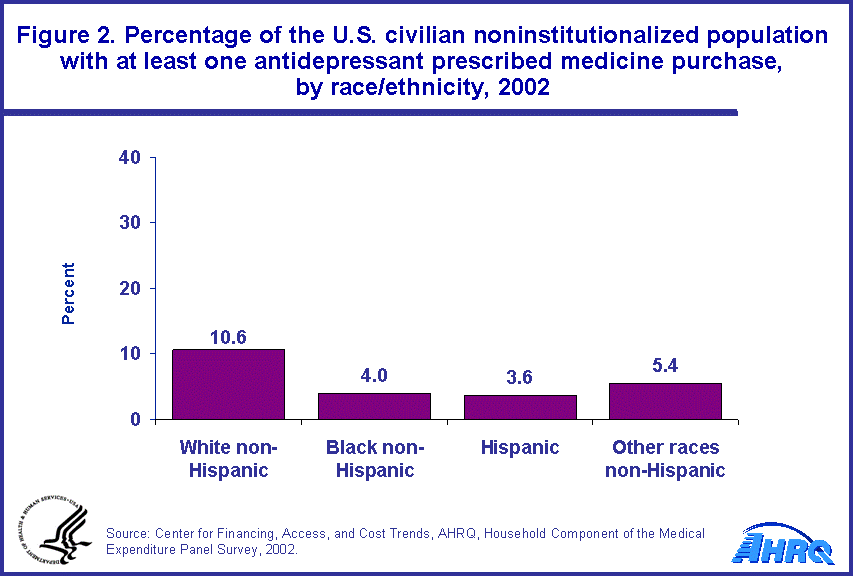 |
||||||||||||||||||||
|
||||||||||||||||||||
|
|
||||||||||||||||||||
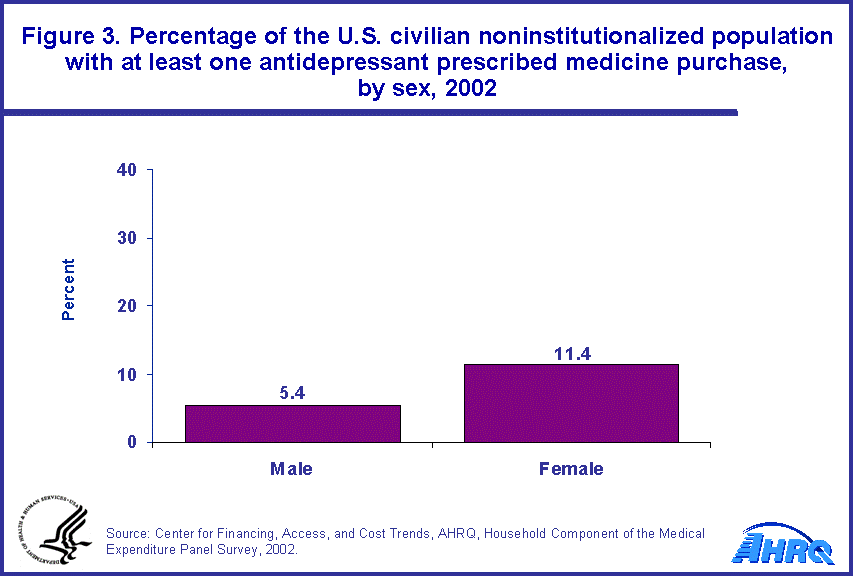 |
||||||||||||||||||||
|
||||||||||||||||||||
|
|
||||||||||||||||||||
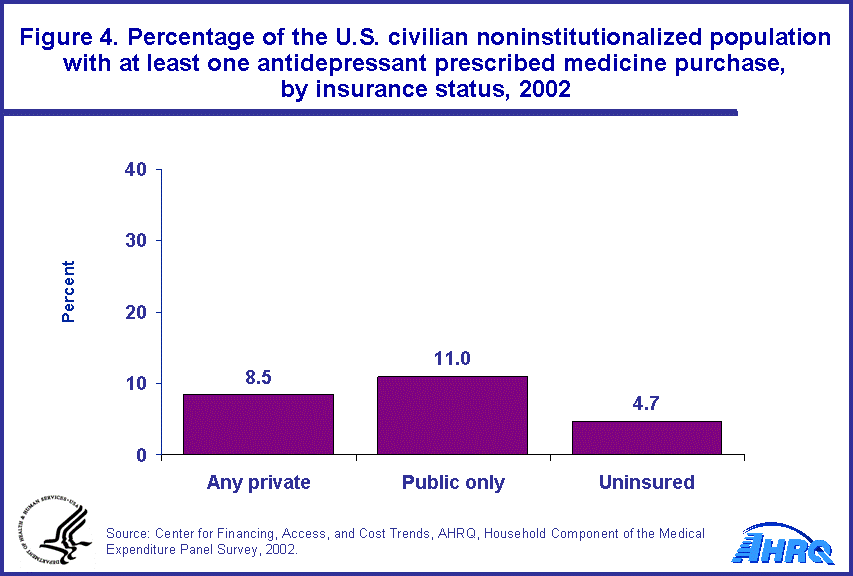 |
||||||||||||||||||||
|
||||||||||||||||||||
|
|
||||||||||||||||||||
 |
||||||||||||||||||||
|
||||||||||||||||||||
|
|
||||||||||||||||||||
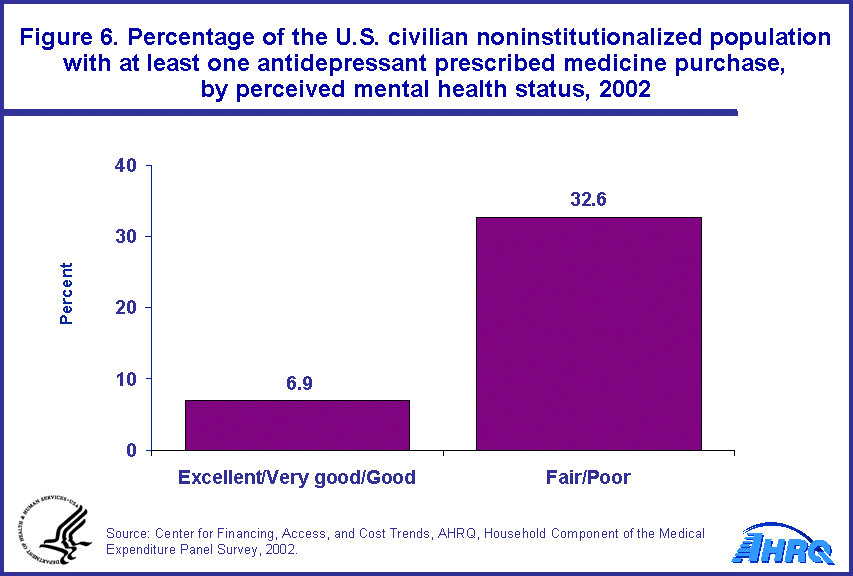 |
||||||||||||||||||||
|
||||||||||||||||||||
|
|
||||||||||||||||||||
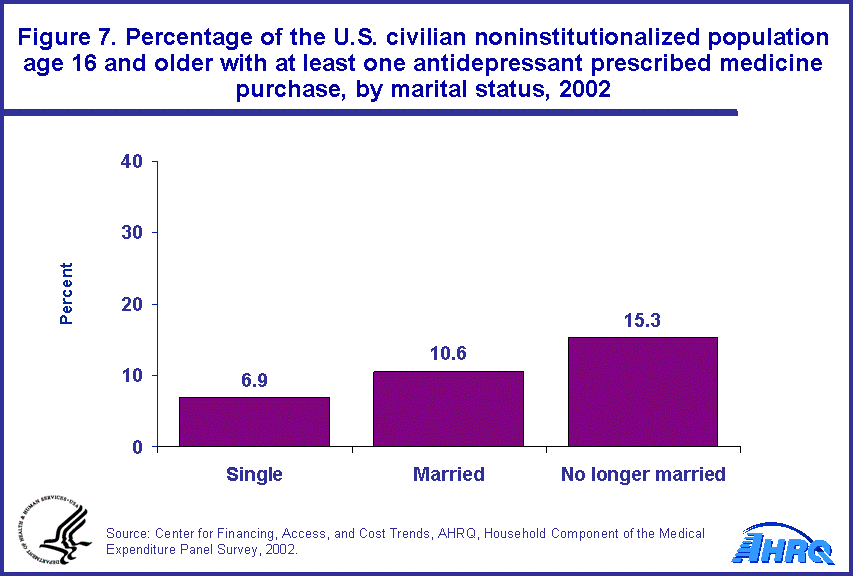 |
||||||||||||||||||||
|
||||||||||||||||||||
|
|
||||||||||||||||||||


